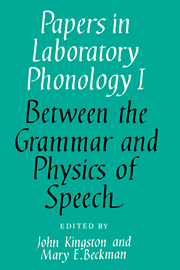Book contents
- Frontmatter
- Contents
- List of contributors
- Acknowledgements
- 1 Introduction
- 2 Where phonology and phonetics intersect: the case of Hausa intonation
- 3 Metrical representation of pitch register
- 4 The status of register in intonation theory: comments on the papers by Ladd and by Inkelas and Leben
- 5 The timing of prenuclear high accents in English
- 6 Alignment and composition of tonal accents: comments on Silverman and Pierrehumberf's paper
- 7 Macro and micro F0 in the synthesis of intonation
- 8 The separation of prosodies: comments on Kohler's paper
- 9 Lengthenings and shortenings and the nature of prosodic constituency
- 10 On the nature of prosodic constituency: comments on Beckman and Edwards's paper
- 11 Lengthenings and the nature of prosodic constituency: comments on Beckman and Edwards's paper
- 12 From performance to phonology: comments on Beckman and Edwards's paper
- 13 The Delta programming language: an integrated approach to nonlinear phonology, phonetics, and speech synthesis
- 14 The phonetics and phonology of aspects of assimilation
- 15 On the value of reductionism and formal explicitness in phonological models: comments on Ohala's paper
- 16 A response to Pierrehumbert's commentary
- 17 The role of the sonority cycle in core syllabification
- 18 Demisyllables as sets of features: comments on Clements's paper
- 19 Tiers in articulatory phonology, with some implications for casual speech
- 20 Toward a model of articulatory control: comments on Browman and Goldstein's paper
- 21 Gestures and autosegments: comments on Browman and Goldstein's paper
- 22 On dividing phonetics and phonology: comments on the papers by Clements and by Browman and Goldstein
- 23 Articulatory binding
- 24 The generality of articulatory binding: comments on Kingston's paper
- 25 On articulatory binding: comments on Kingston's paper
- 26 The window model of coarticulation: articulatory evidence
- 27 Some factors influencing the precision required for articulatory targets: comments on Keating's paper
- 28 Some regularities in speech are not consequences of formal rules: comments on Keating's paper
- Index of names
- Index of subjects
16 - A response to Pierrehumbert's commentary
Published online by Cambridge University Press: 08 February 2010
- Frontmatter
- Contents
- List of contributors
- Acknowledgements
- 1 Introduction
- 2 Where phonology and phonetics intersect: the case of Hausa intonation
- 3 Metrical representation of pitch register
- 4 The status of register in intonation theory: comments on the papers by Ladd and by Inkelas and Leben
- 5 The timing of prenuclear high accents in English
- 6 Alignment and composition of tonal accents: comments on Silverman and Pierrehumberf's paper
- 7 Macro and micro F0 in the synthesis of intonation
- 8 The separation of prosodies: comments on Kohler's paper
- 9 Lengthenings and shortenings and the nature of prosodic constituency
- 10 On the nature of prosodic constituency: comments on Beckman and Edwards's paper
- 11 Lengthenings and the nature of prosodic constituency: comments on Beckman and Edwards's paper
- 12 From performance to phonology: comments on Beckman and Edwards's paper
- 13 The Delta programming language: an integrated approach to nonlinear phonology, phonetics, and speech synthesis
- 14 The phonetics and phonology of aspects of assimilation
- 15 On the value of reductionism and formal explicitness in phonological models: comments on Ohala's paper
- 16 A response to Pierrehumbert's commentary
- 17 The role of the sonority cycle in core syllabification
- 18 Demisyllables as sets of features: comments on Clements's paper
- 19 Tiers in articulatory phonology, with some implications for casual speech
- 20 Toward a model of articulatory control: comments on Browman and Goldstein's paper
- 21 Gestures and autosegments: comments on Browman and Goldstein's paper
- 22 On dividing phonetics and phonology: comments on the papers by Clements and by Browman and Goldstein
- 23 Articulatory binding
- 24 The generality of articulatory binding: comments on Kingston's paper
- 25 On articulatory binding: comments on Kingston's paper
- 26 The window model of coarticulation: articulatory evidence
- 27 Some factors influencing the precision required for articulatory targets: comments on Keating's paper
- 28 Some regularities in speech are not consequences of formal rules: comments on Keating's paper
- Index of names
- Index of subjects
Summary
I thank both Pat Keating and Janet Pierrehumbert for their thoughtful and constructive oral comments on my paper during the conference. I especially thank Janet Pierrehumbert for offering the above written commentary.
Pierrehumbert raises the issue of the connection between generality and reductionism (“A researcher … has a choice whether to aim for reduction or for generality”). The connection or lack of it is, I think, a very simple matter. In explanations the link is obligatory. To explain the unfamiliar by reducing it to the familiar means to bring the unknown into the fold of the known and therefore to enlarge the domain to which the explicanda apply, thus achieving greater generality. An example is Watson and Crick's explanation of the genetic code and the mechanism of inheritance by reducing it to previously known chemical facts, e.g. how adenine bonds only with thymine and cytocine only with guanine in such a way as to guarantee the construction of exact copies of molecular chains (DNA) consisting of those substances. Needless to say, in cases like this it may take genius and inspiration to figure out which facts to bring together into an explanation.
One can achieve generality without reduction but then this is a form of description. Explanation is deductive generalization; a systematic description of a sufficiently wide range of phenomena is inductive generalization. One of the points in my paper was that nonlinear phonology is a good description of certain sound patterns. Pierrehumbert seems to agree with me, then.
- Type
- Chapter
- Information
- Papers in Laboratory Phonology , pp. 280 - 282Publisher: Cambridge University PressPrint publication year: 1990



